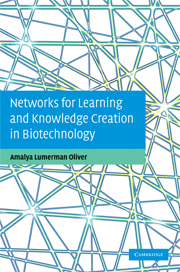Book contents
- Frontmatter
- Contents
- List of figures
- List of tables
- Acknowledgements
- Introduction
- 1 Networks, collaborations, and learning and knowledge creation
- 2 The biotechnology industry through the lenses of organizational and networks scholarship
- 3 New organizational forms for knowledge creation in biotechnology
- 4 Scientific entrepreneurship
- 5 Science and discoveries in the context of private and public knowledge creation and learning
- 6 The search for university–industry collaborations: linear and chaotic networking processes
- 7 Trust in collaborations and the social structure of academic research
- 8 Organizational learning and strategic alliances: recombination and duality of competition and collaboration
- 9 Further directions for understanding interorganizational collaborations and learning
- References
- Index
2 - The biotechnology industry through the lenses of organizational and networks scholarship
Published online by Cambridge University Press: 04 July 2009
- Frontmatter
- Contents
- List of figures
- List of tables
- Acknowledgements
- Introduction
- 1 Networks, collaborations, and learning and knowledge creation
- 2 The biotechnology industry through the lenses of organizational and networks scholarship
- 3 New organizational forms for knowledge creation in biotechnology
- 4 Scientific entrepreneurship
- 5 Science and discoveries in the context of private and public knowledge creation and learning
- 6 The search for university–industry collaborations: linear and chaotic networking processes
- 7 Trust in collaborations and the social structure of academic research
- 8 Organizational learning and strategic alliances: recombination and duality of competition and collaboration
- 9 Further directions for understanding interorganizational collaborations and learning
- References
- Index
Summary
A review of the organizational literature shows evidence not only of a steady increase in the number of studies on the biotechnology industry all over the world, but also increasing scope of research on many related organizational topics. Although initial organizational studies of the biotechnology industry focussed mainly on interorganizational networks of collaborations, more recent research also focusses on patents, scientific citations, strategy, firm emergence, entrepreneurship, intellectual property rights, trust, learning, and university–industry technology-transfer.
This chapter will attempt to chart much of the research published in recent years on a wide range of organizational issues related to the biotechnology industry. It will also review some literature on related “knowledge-intensive” industries (such as information technology (IT) or nanotechnology), in order to search for possible similarities or differences, and will question these patterns.
The biotechnology industry and central organizational actors
In general, “biotechnology” is not a single technology but a family of technologies that have emerged from basic scientific research in molecular biology, including gene-splicing, cloning, and protein chemistry. The commercial implications of biotechnology are potentially enormous and have been well understood since the 1950s, when genetics research first began to make significant progress. However, it was not until the mid-1970s, that biotechnology became sufficiently advanced to allow commercial development of marketable products. Today there is a large population of firms involved in the commercialization of biotechnological products and processes, and these are commonly defined as the “biotechnology industry.”
- Type
- Chapter
- Information
- Publisher: Cambridge University PressPrint publication year: 2009



